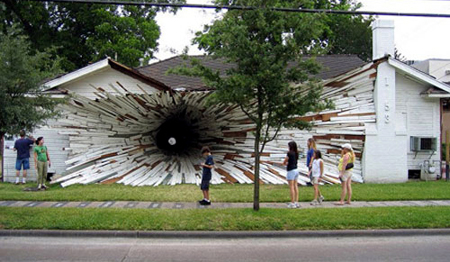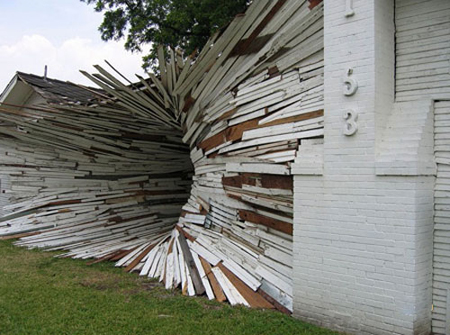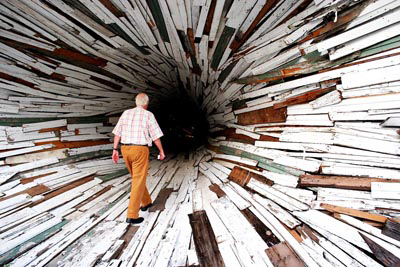Black Hole House
Dan Havel and Dean Ruck
Inversion, 2005



A black hole is an object with a gravitational field so powerful that a region of space becomes cut off from the rest of the universe – no matter or radiation, including visible light, that has entered the region can ever escape. The lack of escaping electromagnetic radiation renders the inside of black holes (beyond the event horizon) invisible, hence the name. However, black holes can be detectable if they interact with matter, e.g. by sucking in gas from an orbiting star. The gas spirals inward, heating up to very high temperatures and emitting large amounts of light, X-rays and Gamma rays in the process while still outside of the event horizon.
While the idea of an object with gravity strong enough to prevent light from escaping was proposed in the 18th century, black holes as presently understood are described by Einstein’s theory of general relativity, developed in 1916. This theory predicts that when a large enough amount of mass is present within a sufficiently small region of space, all paths through space are warped inwards towards the center of the volume. When an object is compressed enough for this to occur, collapse is unavoidable (it would take infinite strength to resist collapsing into a black hole). When an object passes within the event horizon at the boundary of the black hole, it is lost forever (it would take an infinite amount of effort for an object to climb out from inside the hole). Although the object would be reduced to a singularity, the information it carries is not lost.
While general relativity describes a black hole as a region of empty space with a pointlike singularity at the center and an event horizon at the outer edge, the description changes when the effects of quantum mechanics are taken into account. The final, correct description of black holes, requiring a theory of quantum gravity, is unknown.

Simulated view of a black hole in front of the Milky Way. The hole has 10 solar masses and is viewed from a distance of 600 km. An acceleration of about 400 million g is necessary to sustain this distance constantly.
april 6th, 2009 at 01:12
i wish i could really really really see inside a black hole without getting hurt or anything
april 6th, 2009 at 01:19
iam doing a speech about black holes and i wish i could answer every questoin that could be asked about the black hole so i would win
juni 6th, 2009 at 22:20
the very existence of black holes is in question, we can’t be 100% sure that Einstein’s theory should necessary work for this much mass gathered in such small volumes, the theory certainly has its limitations and it may well be that for such case scenarios with such gigantic densities of matter it stops working. Noone’s seen a black hole per ce, scientists can only hazard guesses as regards black holes
augustus 21st, 2009 at 20:32
At the very center is an infinte amount of energy trying to escape but also being pulled inward. The center would be a huge mass of cosmic energy of all types of things. Time would also slow down the closer you got to the center of the hole and matter would stabalize.